Making cycling irresistible in DC 2.0 | Revisiting a post from 2008
In 2008, Rails to Trails was putting together a case for a special federal appropriations program for trails and biking, and they asked each state to submit a policy outline.
The then chair of DC's Bicycle Advisory Committee asked me to write a paper with recommendations that they could review and consider as part of the process for preparing their response.
My one criticism of the general proposal by Rails to Trails was that it was very "bicycling as recreation" focused and not very "urban-centric" and I responded that since DC functions as a state for federal transportation planning purposes but is a city, we should tender a policy outline that is decidedly urban-centric.
Back then DC had some bike lanes and bike parking, police on bikes, and a small permanently constrained bike share test project, and not much bike accommodation beyond that.
This is the paper I came up with: "Ideas for Making Cycling Irresistible in Washington, DC," which suggests cycle tracks and other bike-specific accommodations, suggests switching some government jobs to bike-enabled (like parking control officers), having a payroll deduction program to buy bikes, making transit (Metrorail, VRE, MARC) more bike-accepting, expanding bike parkingprogramming , etc.
The title is a kind of riff on a paper by Ralph Buehler of Virginia Tech and John Pucher of Rutgers, "Making Cycling Irresistible: Lessons from Europe and North America."
When I worked in Baltimore County, the person from Maryland State Highway Administration on our advisory committee circulated it at SHA, and it helped to spark their interest in cycletracks. I believe that including better cycle facilities in the part of the Purple Line not associated with the Capital Crescent Trail in part resulted from the circulation of that paper.
Anyway, a few weeks ago there was a piece in GGW ("A protected bikeway on Florida Avenue? Yes please!") about a cycletrack proposal on Florida Avenue NE (ironically I suggested that there be a road diet program for that street in 2005) and I thought some of the comments were overly negative and I responded thusly:
FWIW, these types of lanes were pioneered by the Dutch. I first saw them in use in Montreal. And at the ThinkBike Dutch bike planning meeting in 2010, they pushed bi-directional lanes. I was skeptical then. I am fine with them now.
They do create issues wrt signaling, etc., making it more expensive than a lane on each side of the street. But a high quality cycletrack as opposed to an average lane on each side of the street is probably preferred, is more visible, etc., and I think that matters.
Maybe I am worn down by reality, and I f*ing hate it when people say "don't let the perfect be the enemy of the good," but I think this is a fine step and helps to alleviate what would be opposition otherwise. ...
I really hated Lindblom's writngs on "incrementalism" when I was first exposed to them in the early 1980s. I couldn't understand why people didn't focus on achieving the best possible result.After those comments, I had a private email exchange with an old H Street compatriot who is a planner for a road engineering firm where we talked about "incrementalism" and how it's time consuming and sometimes oh so slow, but when there is a general commitment to an overall plan and vision, it works -- even if too often it can be half-a****.
After a few decades of living in the real world, I understand the concept a lot better. It's almost impossible to move people far along the idea-vision curve to perfection in one fell swoop. (Although the challenge is to constantly keep moving forward. Too often, stasis results at some point.)
I still push for ideal and vision, but the reality is, year by year, DC is experiencing significant gains in bike infrastructure, and that should be recognized and acknowledged and appreciated.
Where I see my role generally is pushing for the ideal in an issuespace where most people are pretty content with the average or sub-average.
Maybe I am fooling myself more generally, but I don't think so. Even though I am not calling for "the perfect" here, it's so much better than the current conditions it's unimaginable--take it as someone who used to ride on this street many times/week, and still ride it a couple times/week
Since then I have been taking stock of where DC is facilities-wise in terms of biking as transportation, a kind of assessment of my "Making Cycling Irresistible in DC" piece. And in terms of "incrementalism" it is quite a positive track record.
=======
Biking for transportation improvements in DC since 2008
The other day I was riding through the intersection at Florida and New Hampshire Avenues NW and looking at the extension of the 15th St. cycletrack from V Street, going up around Meridian Hill Park, I was so shocked.
It's gorgeous. Like Montreal ("Is Montreal the number one city for bicycling in North America," 2010).
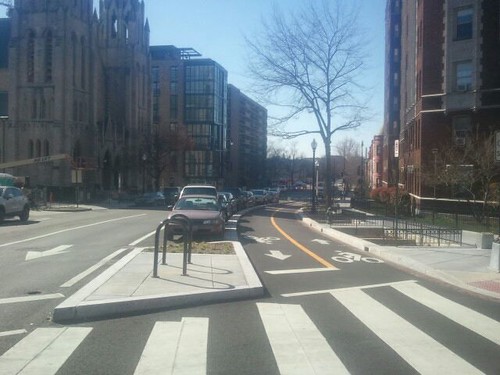
Cycletrack on 15th Street NW, looking west towards U Street (at W Street)
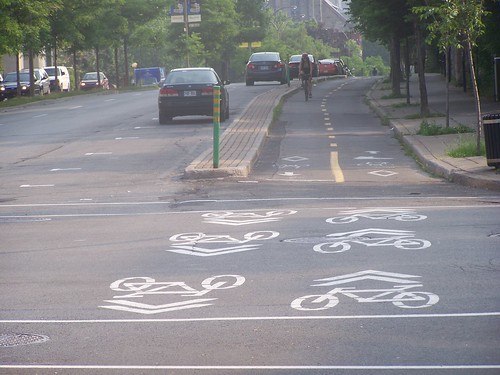
Cycle track (piste cyclable) in Montreal
And it pushed me forward to a more formal assessment of the bicycle facilities improvements across DC since 2008, when I wrote that piece. One by one the improvements are incremental. Collectively they add up to something significant.
(Rather than describe each treatment, see Urban Bikeway Design Guide, National Association of City Transportation Officials.)
★ more bike lanes
★ more bike parking and bike parking corrals on the street (Adams Morgan, Georgetown, 11th St. NW, etc.)
★ a bike share program (although I still have my doubts) that keeps expanding within the city and throughout the metropolitan area
★ regular printing and updating of the DC bike map (many communities have stopped printing maps)
★ cycletrack pilots leading to a growing network of cycle tracks (Pennsylvania Avenue, 15th, L, M, 6th St. NE, 1st St. NE, etc.)
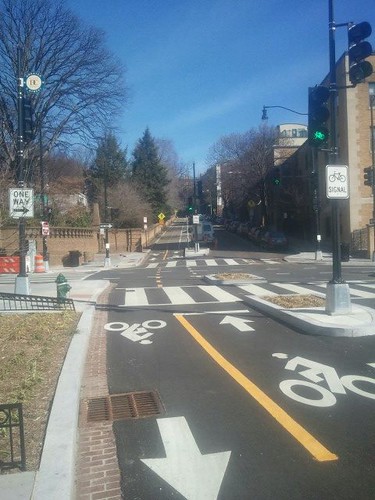
Cycletrack on 15th Street NW, looking east towards Meridian Hill Park (at W Street).
★ opening of a dedicated segment of the Metropolitan Branch Trail (although it will take more than 30 years since this trail was first proposed before it is finally realized)
★ bike favorable traffic treatments (bike boxes, bike traffic signals, painted markings across intersections, etc.)
★ contra-flow lanes for bicycle traffic introduced on one-way streets and the network of such lanes increasing
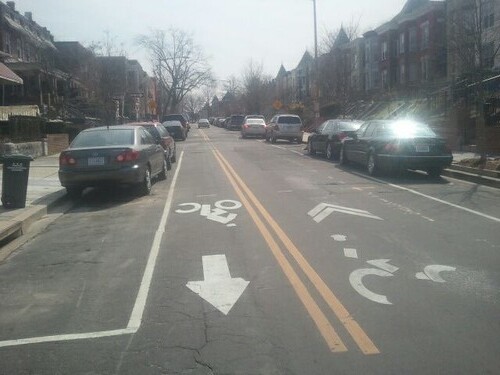
A contraflow bicycle lane in DC.
★ a signage program for "neighborhood bikeways"
★ improved treatments at "complicated intersections" creating various types of "pocket lanes" for through or turning bike traffic, e.g., on the northwest corner of 2nd St. NE going southbound at Massachusetts Avenue, by AU, at Hawaii Ave. and Taylor St. NE, etc.
★ completion of missing Anacostia River Trail segment on the east bank of the river (opened in 2016)
★ printing some not particularly scintillating trails brochures (WABA did it paid for by DDOT)
★ the BikeDC city-wide biking event (not that I do that kind of ride)
★ installation of some bike repair stands and air pumps (although the air pumps are substandard for high use locations and most break) by DGS and some BIDs
★ climbing lane on 14th St. NW
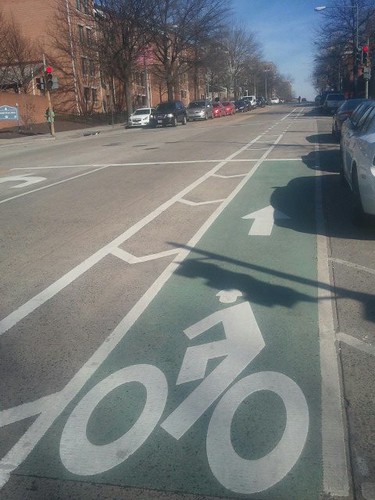
Climbing lane on the south side of 14th Street NW, north of Florida Avenue.
★ more neighborhood bike shops
★ more new buildings adding higher quality secure bike parking, including air pumps, lockers, etc.
★ more bike centric building improvements planned (building on MBT at Florida Ave., Rhode Island Ave. -- I proposed something similar at Monroe St. Market in Brookland 6 years ago and they didn't get it at all, other than a bike shop; now buildings are being very forward)
★ bike-based paramedics deployed for special events
★ expansion of biking training in the local schools
One theoretically is an improvement, but I think it was way too expensive for what you get:
★ Bike Station at Union Station ($4.5 million for 125 bike parking spaces, a bike rental operation, and bike repair)
And one improvement for DC residents but not done by a DC Government entity:
★ allowing bicycles on MARC Penn Line trains on the weekends (which is in the process of being expanded to M-F)
In terms of street safety, compared to 9 years ago, I believe that I experience much less hassling by motor vehicle operators while riding, and that more motor vehicle operators defer to me as a cyclist/the more vulnerable user even when I don't have the right of way. Sure there are still problems, but a couple times/year versus a couple times/week.
And don't forget to acknowledge the work of DDOT's Sustainable Transportation unit for making it happen and their continuous efforts to improve the system.
Next generation bicycle planning and programming for DC (and other places)
There's still a lot more to be done though--many of the recommendations in the original paper still haven't been implemented fully or remain on the list of what could be, and that's where I need to focus my writing.
Especially programming. In a car-centric world, people need focused help to make the transition to biking as transportation. Also see "What should a US national bike strategy plan look like?," "Are developers missing the point on eliminating parking minimums?: it's to promote sustainable transportation modes," and "More bikes: elements of a Bicycle Friendly Community."
In short, we've been effective at creating biking-appropriate infrastructure, but that goes only so far in shifting people to bicycling in a mobility paradigm where the car is still king. At a certain point, you have to be more purposive as there is only so much usage can be realized via trickle down benefit from bike infrastructure.
Focusing on creating bicyclists as well as infrastructure would would make a big difference in terms of the still omnipresent opposition to the expansion of bicycle accommodations in various quarters, because if there were a lot more bicyclists, visible, a lot of the time, then motor vehicle operators wouldn't feel justified in criticizing bicycle infrastructure as being infrequently used (see "(Not exactly) Bike sharing as "Critical Mass," bikelash and changing mobility paradigms: some lessons from Salt Lake City," 2013).
While we see a fair number of bicyclists in certain areas of DC such as Capitol Hill, or at certain times of the day on trails, the ridership levels aren't so high that they register even in the eyes of the otherwise indifferent.
Remember, getting significant levels of use for bicycling as transportation, a system-structural approach is required.
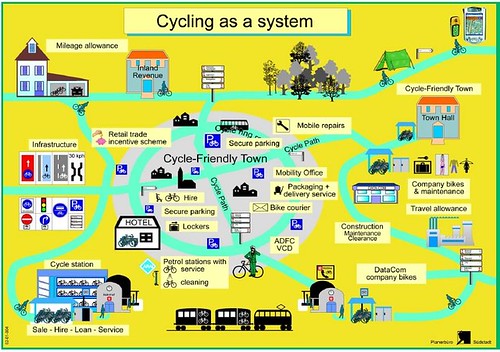
Bicycle Traffic as a system, diagram, German National Bicycle Plan, 2002-2012
While this isn't a complete list, these are many of the elements required for:
Making cycling irresistible in DC 2.0
Planning
★ Adopt the sustainable mobility platform concept to shape transportation planning
★ create bike infrastructure and facilities plans at the neighborhood and district scales (the current DDOT "Livability Plan" process is too idiosyncratic and unsystematic as it relates to this)
★ updating bike parking regulations so that parking amounts are based on likely use rather than the square footage of a building or use (see "Are developers missing the point on eliminating parking minimums?: it's to promote sustainable transportation modes" and "Best (or at least better) practices in bike parking and bicycle facilities implementation")
★ adoption of the guidelines for lane width from the FHWA Shared-Use Path Level of Service Calculator rather than outdated AASHTO guidance (this is especially true for the National Park Service)
★ getting the bi-ennial American Trails national conference to meet in DC as a way to push bicycle facilities improvements efforts across DC and the metropolitan area
★ the informal Capital Trails Coalition of area governments, bike groups, and the NPS should be formalized as a standing committee of the MWCOG Transportation Policy Board
★ define a metropolitan bikeways network, develop it, and promote it
★ include a maintenance element in the Bicycle Master Plan (Minneapolis is a model) that reflects seasonality (e.g., special maintenance for winter, although DC does clear snow from most shared use paths, better than surrounding jurisdictions)
Support Facilities and Infrastructure
★ more innovative parking treatments for dense neighborhoods such as Columbia Heights, at Metrorail stations, parks,special events venues, etc.
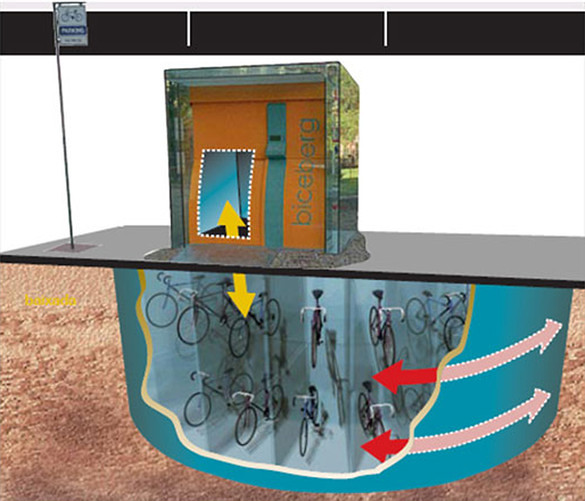
Biceberg underground bicycle parking has a capacity for up to 92 bicycles
★ creation of a network of secure bicycle parking, comparable to the Australian Parkiteer program in Melbourne/Victoria State--a system of more than 90 secure bike parking facilities open to members, regardless of location
★ installation of bike repair stands and high quality public air pumps at transit stations
★ installing only high quality air pumps instead of ones that break down frequently (change building regulations to specify certain types of air pumps for certain locations, based on likely use weighted to the location)
★ posting area and city-wide bike maps at Metrorail stations and transit centers (although bike share station maps provide some of this information at the sub-neighborhood and sub-district scale)
★ DC Government facilities should not be allowed to install sub-standard bike parking and current sub-standard bike parking should be replaced
★ better wayfinding signage generally, definitely improved signage for the 14th Street Bridge crossing between DC and Virginia
★ necessary additions to standard bike route wayfinding signage include bike shops, and the location of air pumps and repair stands
★ misters?
★ Rebuild the Suitland Trail, finish the MBT, install a cycle track across Rock Creek Park on Military Road NW, finish the sidewalk on the park side of Fort Totten Drive NE, creating a virtual cycle track, etc.
★ More and better amenities for trails
★ Improve bike and pedestrian access to parks in a systematic fashion ("A gap in planning across agencies: Prioritizing park access for pedestrians, bicyclists and transit users compared to motor vehicle access")
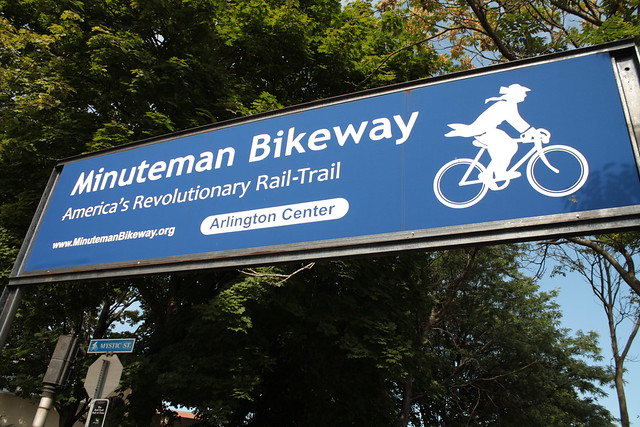
Minuteman Bikeway signage, Greater Boston
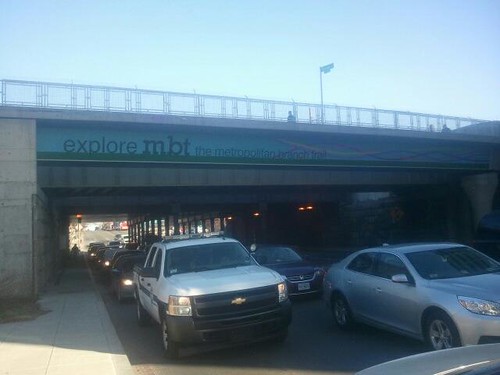
I just noticed that there is an MBT "billboard" painted on the bridge over Florida Avenue NE, although I would argue the signage is a bit too arty and should have graphics of bicyclists and pedestrians within the design to make it very clear.
★ installation of bike counters
★ better bike gutters (most of them now are sub-standard)
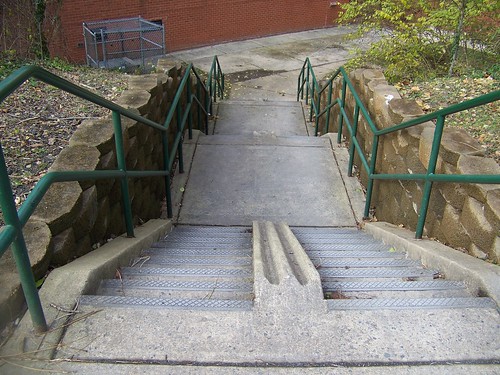
The best bike gutters for this area are on the Capital Crescent Trail in Bethesda.
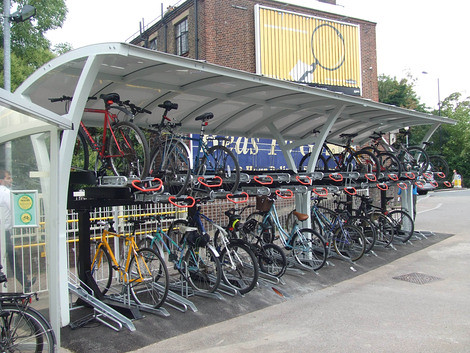
Double deck bicycle parking at Sutton Station, Southern Railway, UK.
Programming/Promotion
★ integrating programming, bike co-ops etc. into city recreation and community centers and schools
★ payroll deductions/loan programs to buy bikes for transportation (this is done in the UK, maybe a city like DC could help to pilot what should be a national program)
★ programs to get bikes to kids regardless of household income
★ programs facilitating bike take up by low income segment (e.g., "Creating a Commuter" program of the Community Cycling Center of Portland; Major Taylor Bike Clubs, etc. -- see "Eight "mutual assistance programs" that can build support for biking as transportation on the part of low income communities," 2015)
★ special programs to promote bike usage at public housing (and universities)
★ more programs to facilitate bike delivery, cargo bike usage, etc.
★ annual biking for transportation expo for DC (use the UTA Bike Bonanza program as one model) to promote bike use and
★ annual metropolitan sustainable mobility programming conference (use the Texas Trails Summit as an example)
★ Why doesn't DC have an amazing "Open Streets" program? (CicLAvia in Los Angeles is held in the spring and the fall and more than 100,000 people typically come out; blog entry)
★ Bike to Work Day is part of Bike Month, Bike Month needs a wider range of activities (blog entry)
★ create and distribute a metropolitan bikeways map
★ Better Leverage "National Trails Day" "National Public Lands Day," and the new "Bike Your Park Day" (the same day as NPLD) to promote biking, and trails use, maintenance, and expansion specifically
Enforcement/Safety/Maintenance
★ legalization of the Idaho Stop ("Failure to pass the Idaho Stop as an indicator of lack of commitment to DC's Sustainability Plan by DC's elected officials)")
★ requiring multiunit residential to improve bike parking security, triggered when a bike is reported stolen (most of the news coverage I've seen of this issue generally indicates very insecure and substandard bike parking, with big holes in security)
★ neighborhood bikeway streets should have a 20mph speed limit (Tucson does this)
★ develop a better program for maintenance of bike lanes, especially cycle tracks including clearance of debris
Other
★ should a Velodrome be created as part of the program for re-articulating the recreation and facilities program at the RFK Campus?
★ urban bike tourism promotion as part of the city's tourism promotion efforts
What about bike sharing? The DC bike sharing system is considered one of the most successful in the US, although it hasn't experienced significant membership growth and the reason it operates profitably is because tourists rack up serious bank in additional use charges.
I am two minds about it. It promotes biking and is very visible.
At the same time, I have to believe that the same amount of money spent on bike share would have significantly more benefit if spent on the items identified above ("On your bike: the best and the worst of city cycle schemes," Guardian; and "How much does each bike share ride cost a system? Let’s do the math," Better Bike Share Partnership).
When evaluating the success of bike share, typically bike share is compared to transit in terms of costing on a per trip basis (e.g., "Do bike share systems actually work?," Outside).
While that is an important comparison, it's not the right comparison.
First, transit is a mass phenomenon while biking is a form of personal mobility. Yes, formal bike share programs make biking an element of sustainable mobility product service systems, but it still moves people one at a time, even if that can be a lot simultaneously--1,000 bikes equals the capacity of about 20 buses, but the buses "rebalance" naturally while "operator intervention" is often needed for the bikes.
Second, money spent on bike share should be compared to the potential benefit of money spent in other ways to facilitate and encourage bicycling for transportation. See "Bike share and sustainable bike share systems: sometimes other programs can have more effect for less cost" and "The problem when you define every outcome as a succoess, you don't learn, and therefore failure is more likely: bike share in Seattle and Los Angeles as examples."
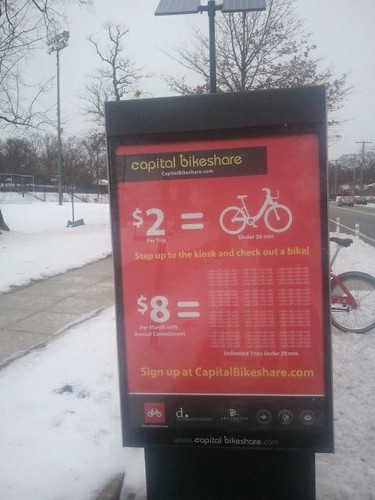
Now the DC area bike sharing system will allow people to pay $2 for a single ride--which is about the same as the cost of a bus ride.
In most US cities, the bikes aren't getting used enough to justify the amount of public spending on the program ("Public bike sharing: analyzing the usage data in the US," Priceonomics). Although some programs are privately funded so there it isn't a matter of judicious use of public funding.
By contrast, European cities have bike share bike daily use rates 2x to 5x higher than those in DC ("Bike share boom: 7 cities doing it right," CNN). For example each bike in the Lyon (France) system makes more than 5 round trips per day, while in the DC system a bike share bike makes about one round trip per day.
One program that I think cities should be adopting is what the British call "Cycle to Loan Schemes," a program that is either free or very low cost where people can borrow a bike, helmet, and lock for a few weeks to try it out, instead of paying upwards of $600 on a bike, helmet, lock, and lights before even starting to try biking.
The London Cyclist Campaign is a lead organizer of such programs, Urban Cycle Loan, which were written about in CityLab, "How Cycling Is Becoming More Equitable in London."
Note with bike share, for years I've recommended active marketing programs. Some of the systems in the US are starting to do this. The system in London is probably the best.
Making bike lighting standard equipment when purchasing a bike. Another change that is very important, but requires federal legislation, would make biking at night safer by (1) making bike lights for the front and rear of a bike required standard equipment on certain types of bikes most likely to be used for transportation (e.g., hybrid bikes yes, racing bikes no). (2) creation of a bike turn signal as part of the rear light--although this should be visible during the day as well.
Enforcement. Bicyclists argue that there needs to be more enforcement of errant driving by motorists. Motorists resent speed cameras, red light cameras, parking tickets, and other what they consider "infringements"on their "right" to drive.
Fortunately, because of Pierre L'Enfant's grid of streets and blocks being human-scaled, for the most part, DC has fewer bicyclist deaths than most cities. But there are still deaths and accidents (the right hook especially) and from time to time bicyclists kill pedestrians too, even recently ("Pedestrian struck by cyclist in Downtown DC dies," Washcycle).
Rather than see regular speeding and other infractions as deliberately breaking the law, motorists prefer to focus on what they perceive as "all those damn cyclists running red lights and stop signs." That's why moving legalization of the Idaho Stop beyond the State of Idaho and Paris is very difficult.
I would prefer passing a package of changes, including stricter requirements on motor vehicle operators to drive safely, e.g., in the Netherlands, drivers are presumed to be at fault in any accident involving pedestrians or cyclists, which ends up making them much more careful and responsible, the Idaho Stop, and other measures.
By contrast, the US system of laws and insurance relating to "accidents" mostly forgives negligence except in extreme examples that are judged to be willful.
Labels: bicycle and pedestrian planning, bikesharing, car culture and automobility, change-innovation-transformation, sustainable mobility platform, transportation planning, urban design/placemaking





0 Comments:
Post a Comment
<< Home